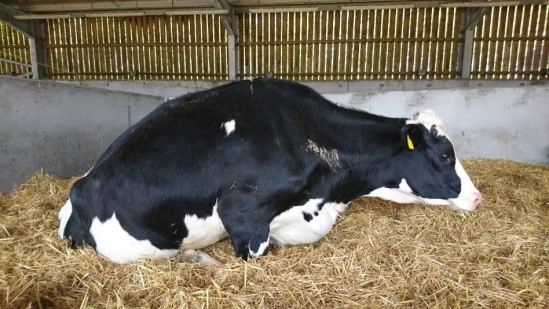THE DOWNER COW SYNDROME
Dr Anita Kumari and Dr Kavipriya Jaiswal
Downer cow syndrome refers to cows that become recumbent and fail to rise; this is a major concern in dairy farms worldwide. The syndrome occurs mainly in the early postparturient period and is caused by several diseases. The most common cause of downer cow syndrome is hypocalcemia (milk fever) but it is also caused by injuries, muscle damage, macromineral deficiencies, toxic mastitis or metritis . Fatty liver may also contribute to cows becoming downers. Almost all high producing dairy cows are in negative energy balance in early lactation because energy requirements exceed feed consumption capacity.
Etiology:
The etiology is not clear but the available evidence and clinical experience suggest that the disease is complication of hypocalcemic parturient paresis. Traumatic injuries of the medial thigh muscles and of the tissues around the hip joint and of the obturator muscles are common in cows which do not recover. The traumatic injuries may be the result of cows “Spread-eagling” their hindlegs if they are unsteady during parturition or if they are forced to get up or walk on a slippery floor immediately before or following parturition. A difficult parturition due to an oversized calf may result in peripelvic traumatic injury with extensive edema of the pelvic (Oedema) and vulva, and failure of the cow to get up following parturition. If these cows develop hypocalcemic parturition paresis, it is unlikely they will get up following treatment with calcium.
Epidemiology:
The incidence of the downer cow syndrome is distressingly high, particularly because so many of the affected animals are heavy produces and of great value. It is impossible to give accurate figures on incidence because of variations in nomenclature and in the accuracy of diagnoses. For example, some find that all cases are caused by nerve injury. Cases included in this classification by some veterinarians are classified by others as maternal obstetric paralysis, as obturator paralysis or as hypophosphatemia. Based on clinical experience and our interpretation of the literature we conclude that the downer cow syndrome is a complication of hypocalcemic parturient paresis. Traumatic injury to leg muscle at the time of parturition or when the cow is unsteady and falls during the first stage of milk fever will result in the inability of the cow to get up quickly following treatment for milk fever. Another plausible complication is an overlong delay (4 hours or more) in the treatment of cows with milk fever which result in ischemic necrosis of the muscles of both the hind legs and forelegs. There is now experimental evidence to support the clinical and epidemiological observation.
Pathogenesis:
Several different primary factors or diseases like parturient hypocalcemia initially cause recumbency .The recumbency results in pressure damage which occurs secondarily and is a factor common to all cases .Traumatic injury to limb muscles and nerves immediately prior to parturition or at the time of parturition can result in prolonged recumbency and subsequent pressure damage . An overlong delay in the treatment for hypocalcemic parturient paresis can result in pressure damage and the subsequent inability to rise after treatment for the primary disease.
Clinical Finding:
The “Downer Cow “syndrome may occur independently, or follow apparent recovery after treatment for parturient paresis, except for the continued recumbency which, in effect, constitutes the disease. In the typical case, affected cow either make no effort or are unable to rise following treatment for parturient paresis . About 30% of cows treated for parturient paresis will not rise for up to 24 hoursThose which are unable to rise after 24 hours and after two treatments can be classified as downers. They are usually bright and alert and although the appetite is reduced, the cow eats and drinks moderately well. The temperature is normal and the heart rate may be normal or elevated to 80-100/min. Tachycardia and arrhythmia occur in some cows especially
Treatment:
Many treatments including the injections of magnesium salts, phosphates, corticosteroids, stimulant tonics and vitamin E and selenium have been used without consistent success. Attempts at slinging are usually unsuccessful unless the cow is partially able to get up on her own. The use of solutions containing potassium, calcium, magnesium and phosphorus has been recommended but there is no scientific evidence that these electrolytes, in addition to what was probably given to the cow already, are indicated of any beneficial value.
Fluid therapy by the oral or parentral route is indicated for cows which may not be drinking a normal amount of water. There is a need to develop a field technique for the provision of physiotherapy in the form of muscle massage to restore the normal muscle activity in the affected limbs. With conscientious care and the provision of good bedding, most cows will attempt to rise in a few days a cows and can stand normally a day or two later. Sand is an ideal from of bedding which facilitates standing when downer cows attempt to stand. If affected cows are left on a slippery ground surface, they will not make an effort to rise and will become progressively worse.
References
- Barrington GM. Parturient paresis in cows. In: Aiello S, editor. The Merck Veterinary Manual. 8th ed. Whitehouse Station, New Jersey: Merck and Co; 1998. pp. 739–741.
- Gerloff BJ. Herd health. In: Radostits O, editor. Food Animal Production Medicine. 3rd ed. Philadelphia: WB Saunders; 2001. p. 465.


